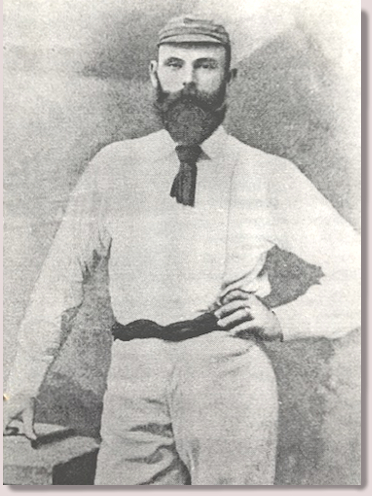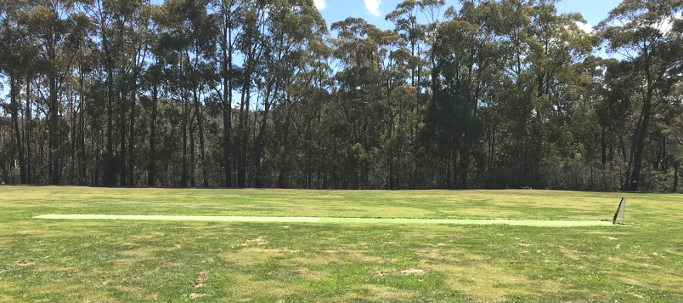|
Home
News
FAQs
History
V-tour
Traders
More info
WH&DL
|
December 26th, 2018.
How Harry Boyle created The Ashes

Henry Frederick Boyle (1847-1907)
The following article from the December, 1992 edition of the Walhalla "Chronicle" describes the brilliant cricketing career of another of Walhalla's international celebrities — Henry F Boyle (1847-1907), shown above, the man who bowled the ball that created the "Ashes".
|
|
Henry Frederick Boyle was born in Sydney in 1847. He played Test Cricket for Australia from 1878 to 1884. and lived in Walhalla in the eighteen nineties and the early years of the twentieth century.
As a young man he worked on the Bendigo Goldfields where his ability as a cricketer attracted attention and he was invited to Melbourne where he played for the East Melbourne club. At that time he worked as a warehouseman.
Boyle was selected for the Victorian team in inter-colonial matches and captained Victoria on a number of occasions.
Henry formed half of the first great opening bowling combination that Australia possessed. He was, however, destined to be regarded as second-fiddle in that he partnered one of the game's immortals, Spofforth, "the Demon". It is hard to imagine two men more unlike in temperament. Boyle was one of the kindest and most tolerant of men. This is not to suggest that when Boyle hit batsmen it hurt him more that it did them, but he would not have enjoyed the experience.
Although Spofforth was the senior partner. at times Boyle returned better figures. He had the honour of taking the wicket which gave Australia victory in the famous "Ashes"· test of 1882 at the Oval, London. The ball with which Harry took this wicket may be seen in the museum of the Melbourne Cricket Club.
Australia had beaten England in Australia before. but Australia was a long way away and that could be ignored. To be beaten in England was another matter and the Brits took it hard.
The following obituary was published next day by the "Sporting Times":
|
|
In Affectionate Remembrance of English Cricket, which died at the Oval on 29th August 1882.
Deeply lamented by a large circle of sorrowing friends and acquaintances. R.I.P.
N.B. the body will be cremated, and the Ashes taken to Australia.
|
|
Australia won by seven runs. It was reported that the atmosphere was intense as England, batting last, crept closer to their target. When Boyle bowled Peate to end the match, it was found that one spectator had died of a heart attack and another had gnawed through the handle of his umbrella!
Boyle was also credited with having invented the fielding position known as "short leg" or "silly mid on". a position where not many have the courage to field. We are used to seeing, on television, David Boon occupying this position. Boon wears a helmet, with face guard, and is obviously padded in other places. We admire Boon's courage. but any protection Boyle had must have been very primitive.
Just how close Boyle got to the batsman we do not know, but we can discount facetious reports of that time that batsmen complained that they could feel him breathing on the backs of their necks, or that they feared he might be there to pick their pockets.
Anyway, Harry stood there unflinchingly despite threats from Dr W.G. Grace and others that he would be killed. He seems to have been hit only once, when a ball driven by E.M. Grace (W.G.'s brother) struck him in the neck. Tom Horan, Australian captain in 1884 described the incident. "We all thought Old Boyley was done for, but he soon picked himself up. gave his neck a twist to set it straight. and went on as if nothing had happened".
As a batsman in his early days Boyle was a rabbit. But he worked on this aspect of his game, and eventually made a century in first class cricket.
Information about Boyle's time in Walhalla is sketchy, although Tom Horan writing [in] the "Australasian" had this to say:
|
|
Down from the mountains
Harry Boyle, down from the mountains, looks first rate, and his right hand is nearly shaken off by numerous friends. Though he attained his fifty-first birthday last month, he made 49 on the hilltop on the Saturday before he left for Melbourne.
I understand from the veteran that you have to do a lot of climbing to get to the Walhalla ground.
|
|
|
Boyle went on five of the first six Australian tours of England, and managed the 1888 team.It was once a point of discussion as to what heights Boyle would have risen had there been no Spofforth. There is no way of knowing. What we do know is that one became "the Demon", the other "Old Boyley".
Late in life Harry Boyle returned to Bendigo where he died in 1907. He is buried in the Bendigo cemetery.
Contributed by: Len Ryan, 86 Clifford Street Warragul
|
|
 The same pitch Harry Boyle played on at Walhalla
The same pitch Harry Boyle played on at Walhalla
If you're old enough to remember the days before television, you might recall how fans could sit riveted, listening to coverage of a distant test match on the radio — you may even have seen how radio broadcasters were able to fake the sound of ball on willow while dramatising telegraphed play-by-play, “live” reports from overseas matches. But even before the advent of public radio — and if done properly — the printed word could be just as gripping, judging by the following report from the “Australasian” of June 27th, 1896 (p17):
|
|
|
Perhaps the most exciting match in the history of cricket was the test match at Kennington Oval on 28th and 29th August, 1882. The best men of England went in for their second innings with 85 to get. Three wickets had fallen tor 51, Hornby, Barlow, and Ulyett. W. G. Grace was still in, with famous men to follow. Presently Grace is caught at mid-off by Alick Bannerman off Boyle. Twelve successive maidens are sent down to the Hon. A. Lyttelton and A. P. Lucas. A single to Lyttelton evokes tremendous cheering. Four more maidens, and Lyttelton falls to the demon, who is bowling with set face, wearing a do-or-die expression.
Boyle at the other end maintains a splendid length. Blackham at the wickets is surpassing himself, and the fielding is faultless ; 19 to get and 5 wickets to fall. A. G. Steel is caught and bowled, and Maurice Read goes down before the unerring arm of the demon. [England all-rounder Billy] Barnes passes me; his lips are ashen grey. “By Jove, Barnes, this is an exciting match!” I say to him. It costs him an effort to speak, but raking up a touch of saliva from somewhere he says, “Yes! but you'll win.” He scores a 2 and 3 byes are run ; 75 up, and 10 to win. A. P. Lucas plays on, and C. T. Studd comes in to see Barnes caught at point by Murdoch off Boyle. The tension for the last half hour has been intense, and the living wall of 22,000 persons is spellbound in silence; so that you fancy you could hear a pin drop. It is tremendous; it cannot last without something giving way. Presently one man drops dead ; Peate is bowled by Boyle, who jumps four feet in the air, and the most exciting match on record is won by Australia by 7 runs. The ground is rushed, the thousands cheer the Australians again and again from ground, gasometer, and thronged balconies and roofs, and the players, borne to the pavilion by the surging mass, are patted on the back a hundred times. It was magnificent, brilliant, never to be forgotten.
Spofforth sent down 44 balls for 2 runs and 4 wickets ; Boyle, 48 balls for 7 runs and 2 wickets.
|
|
|
As the article makes clear, it's no exaggeration to say (in a game that could clearly have gone either way) that the contribution of Walhalla's Harry Boyle was integral to the outcome that disgusted Britons as much as it did — “Beaten by damned colonial convicts, Hortense! and on home soil, too!” — and firmly set in place a sporting rivalry that has persisted ever since, to the point where there's no team that either side prefers to convincingly defeat more than the other!
|
|


